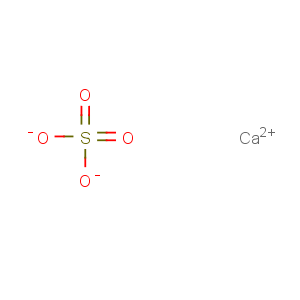Title: Calcium Sulfate
CAS Registry Number: 7778-18-9
Molecular Formula: CaO4S
Molecular Weight: 136.14
Percent Composition: Ca 29.44%, O 47.01%, S 23.55%
Line Formula: CaSO4
Literature References: Review: R. J. Wenk, P. L. Henkels in
Kirk-Othmer Encyclopedia of Chemical Technology vol. 4 (Wiley-Interscience, New York, 3rd ed., 1978) pp 437-448.
Properties: The natural form of anhydrous calcium sulfate is known as the mineral
anhydrite; also as
karstenite,
muriacite,
anhydrous sulfate of lime,
anhydrous gypsum. Crystals are orthorhombic, color varies, e.g., white with blue, gray or reddish tinge, or brick red. d 2.96. Hardness 3-3.5 (Mohs'). Sol in water (18.75°) 0.2 pts/100 pts.
Insoluble anhydrite or
dead-burned gypsum which has the same crystal structure as the mineral is obtained upon complete dehydration of gypsum at above 650°.
Soluble anhydrite is obtained in granular or powder form by complete dehydration of gypsum at below 300° in an electric oven. Estimated pore space is 38% by volume. Possesses high affinity for water and will absorb 6.6% of its weight of water forming the stable hemihydrate.
Density: d 2.96
Derivative Type: Hemihydrate
CAS Registry Number: 26499-65-0
Synonyms: Dried calcium sulfate; dried gypsum; plaster of Paris
Trademarks: Annalin
Properties: Fine, odorless, tasteless powder. When mixed with water, sets to a hard mass.
Keep well closed.
Derivative Type: Dihydrate
CAS Registry Number: 13397-24-5
Synonyms: Native calcium sulfate; precipitated calcium sulfate; gypsum; alabaster; selenite; terra alba; satinite; mineral white; satin spar; light spar
Properties: Lumps or powder. d 2.32. It loses only part of its water at 100-150°. Sol in water; very slowly sol in glycerol. Practically insol in most organic solvents.
Density: d 2.32
CAUTION: Potential symptoms of overexposure to anhydrous compd, dihydrate or hemihydrate are irritation of eyes, skin, mucous membranes, respiratory system; cough. Potential symptoms of overexposure to anhydrous compd also include conjunctivitis; rhinitis, epistaxis. Potential symptoms of overexposure to dihydrate also include sneezing, rhinorrhea.
See NIOSH Pocket Guide to Chemical Hazards (DHHS/NIOSH 97-140, 1997) pp 48, 154, 260.
Use: Anhydrous: Insol anhydrite is used in cement formulations and as a paper filler. Soluble anhydride, because of its strong tendency to absorb moisture, is useful as a drying agent for solids, organic liquids and gases; the desiccant used in laboratory and industry is known under the name
Drierite. This material can be regenerated repeatedly and reused without noticeable decrease in its desiccating efficiency. The
hemihydrate is used for wall plasters; wallboard; tiles and blocks for the building industry; moldings; statuary; in the paper industry. The
dihydrate is used in the manuf of portland cement; in soil treatment to neutralize alkali carbonates and to prevent loss of volatile and dissolved nitrogenous compounds by volatilization and leaching; for the manuf of plaster of Paris, artificial marble; as a white pigment, filler or glaze in paints, enamels, pharmaceuticals, paper, insecticide dusts, yeast manuf, water treatment, polishing powders; in the manuf of sulfuric acid, CaC2, (NH4)2SO4, porous polymers. Pharmaceutic aid (in plaster casts).

